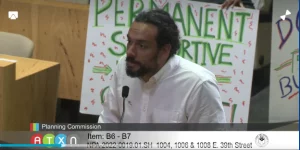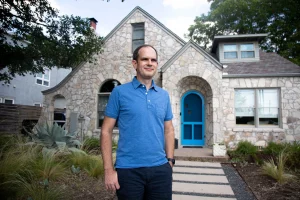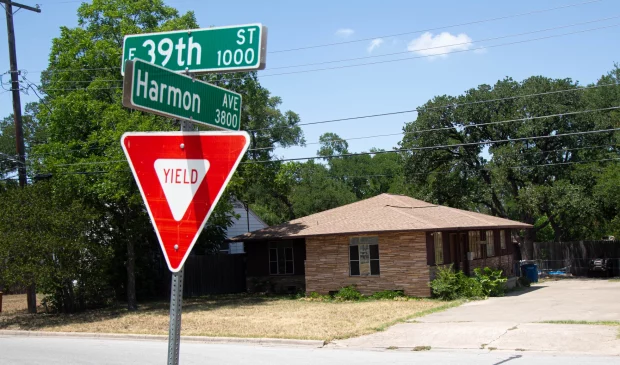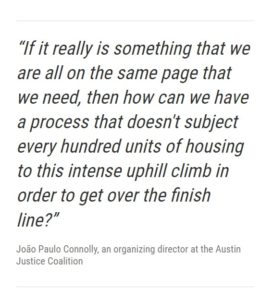Austin’s Planning Commission meets every other Tuesday in the cavernous chambers of City Hall. Members assemble virtually and in person to hear requests and pleas from the public about what should be built in the city. Plot by plot, these volunteers vote yea or nay to changes that will shape Austin.
On a night in late May, the meeting looked more like a protest. A handful of people carried handmade signs demanding in blue marker, “Build Cady now!!!”
The signs referred to a plan to build a 100-unit apartment complex called Cady Lofts between the parking lot of a medical center and a home, just north of the UT Austin campus. While you’d need at least $1,300 a month to afford an apartment nearby, this building would house some of the city’s thousands of unhoused people for a fraction of that price.
The Hancock Neighborhood Association opposed a zoning change developers said they needed to build the complex. But as members showed up to the meeting, so did people from across the city in support.
“I want to send a very clear message to every neighborhood in Austin today: We are prepared to stand up and fight,” said João Paulo Connolly, organizing director at the Austin Justice Coalition. “We will defend every unit of permanent supportive housing that our system needs.”

ATXN. João Paulo Connolly of the Austin Justice Coalition testifies in support of Cady Lofts at the Planning Commission in late May.
Coan Dillahunty, president of the neighborhood association, stepped to the podium to justify the group’s opposition: The building would house too many people, and the timeline was too fast. Some neighbors threatened to sue, while others signed a petition against it.
“Not because we’re opposed to this project or public supportive housing, but we have real concerns about it working in our neighborhood,” Dillahunty said.
No one watching that meeting could come away confused about where members of the neighborhood association stood on Cady Lofts: Nope.
But then, suddenly, that changed. One week after the meeting, the association announced it no longer opposed the development. The story however, as Connolly put it, is “not all Kumbaya.”
After the Planning Commission, the zoning case went on to City Council, which approved it in June. Advocates for affordable housing like Connolly were relieved – and tired.
“We shouldn’t have to fight battles like this to begin with,” he told KUT.
The battle over Cady Lofts entered the public arena a year after Austin residents overwhelmingly voted to reinstate laws banning unhoused people from camping and resting in public. Put plainly, voters made living on the streets a crime.
Proponents of the new laws said their passage sent a clear message to politicians to solve homelessness. In a city rapidly becoming more expensive, that would require building affordable housing – and lots of it. One consultant hired by the city estimated Austin needs thousands more homes like the ones to be built at Cady Lofts.
Even though construction is set to start on the four-story building next year, people who supported Cady Lofts wondered: How do we get people off the streets if each time housing is proposed neighbors tick off the myriad reasons it shouldn’t get built in their backyards?
Build it somewhere else
Initially, the opposition to Cady Lofts didn’t seem so opposed.
At a virtual meeting with consultants for the developer in March, members of the Hancock Neighborhood Association heard how the property would include on-site services for tenants, such as doctors and counselors. This model, called permanent supportive housing, is intended to help people manage medical or mental health issues that may have caused them to lose housing in the past.
It would be funded, in part, by tax credits and a loan from an affordable housing bond passed by voters in 2018. The city’s public housing authority would be a co-owner.

O-SDA Industries, LLC. An early rendering of Cady Lofts. A consultant for the developer said it is working on a new design.
“So far there’s a lot of great things you guys have talked about,” said Josh Ellinger, who lives on the same block as the proposed complex. “I’m pleasantly surprised with what I’m seeing in the development.”
But in an email to city staff two months later, the tone from neighbors was less pleasant. Writing on behalf of the neighborhood association, Dillahunty spelled out nearly a dozen reasons why Cady Lofts should not be built: The value of nearby homes could be negatively impacted, crime might go up and a report written by city staff contained several inaccuracies.
“There are other properties and other funds available for developers to construct homeless housing projects in other areas,” the email concluded.
The area the association was directing developers away from is a rectangular enclave between Interstate 35 and Duval Street. The Hancock neighborhood is a mix of 1970s-era small apartment complexes and one- and two-story homes. Those that sell go for just under a million dollars.
Cady Lofts could have been built without a zoning change and the public process that comes with it. But the plan to build apartments across three plots of land, totaling three-quarters of an acre, snagged on zoning regulations. On one of the plots, the zoning restricted developers from building more than eight apartments, meaning they would have to build much higher than the neighborhood preferred to achieve a total of 100 units. So, developers asked the city to let them build more on that portion of the property.

Patricia Lim/KUT. Coan Dillahunty, president of the Hancock Neighborhood Association, spoke against the Cady Lofts project.
That request is what brought everyone – developers, neighbors, advocates for people living on the streets – to that Planning Commission meeting in late May. After a half hour of discussion, commissioners voted in favor of the zoning change.
The vote came after combative testimony. One neighbor, Lisa Fleck, said adding 100 more people to the neighborhood would be unhealthy, “but especially for the vulnerable people who will be housed.” Another said the lack of sidewalks in the area could be “disastrous” for the new residents, while several said they opposed Cady Lofts because the building would house too many people too close together.
Neighborhood opposition to affordable housing in Austin is nothing new. In a city that espouses liberalism, the refrain is often: We support affordable housing, just not in our neighborhoods. People who express this sentiment are referred to by their opponents as NIMBYs (“not in my backyard”).
Bradley Price, a retired doctor, was one of the few neighborhood association members who spoke in support of the project: “I’m using the same approach that we use in clinical medicine. Does the benefit exceed the risk? By far.”
Awais Azhar, a Planning commissioner, said it’s not unusual for public testimony at these meetings to get contentious. But the two sides at odds are usually the neighbors and the developers. This time was unique.
“This was one of the few times that we see there’s another side to it,” Azhar told KUT. “Other community members clearly telling us this is something important and we should move forward.”
As many neighbors appealed for more time, affordable housing advocates rattled with urgency.
“Why are we even talking about this? This is insane,” Chris Baker, who runs the nonprofit the Other Ones Foundation and works with people living on the streets, told commissioners. “Of course we need more permanent supportive housing. Of course we need it now.”
Neighbors in opposition told KUT that by failing to address homelessness earlier, officials had driven the city to a crisis point – and with the city’s desperation at their heels, those living in the Hancock neighborhood were being asked to roll over and let them build.
“Will the property owners of Austin continue to fund affordable housing when the city forces high-density development into the neighborhoods?” Ellinger asked commissioners.
Living on the streets in Austin
Roughly 2,600 people live outside in Travis County, according to recent estimates by the Ending Community Homelessness Coalition, or ECHO. A consultant hired by the city estimated in 2020 that Austin was short more than 4,800 permanent supportive housing units for people who needed them.
Representatives from ECHO met with the Hancock Neighborhood Association while the Cady Lofts zoning case was being considered. The organization is a consultant on the development, and Cady Lofts will likely house some of the people ECHO works with.
Executive Director Matt Mollica said part of ECHO’s job was to explain what it means to live on the streets.
“We heard a lot from the Hancock Neighborhood Association about how there’s not a great sidewalk (in the area). If someone’s in a wheelchair, how are they going to get around?” Mollica said. “These people that are living in wheelchairs are currently living in the woods in the wheelchair and having to get in and out of really unsafe situations.”
Along with Mollica, a man named Chase Wright testified in support of Cady Lofts at that Planning Commission meeting in May. Wright, who grew up in East Austin, founded an organization called Springdale Park Neighbors to help unhoused people sleeping in the park.
While Cady Lofts isn’t set to be finished for a couple of years, Wright told commissioners some of the people he works with might someday live there.
“We have a lot of unhoused residents in that area that could possibly benefit from these units,” he said.
Some of those residents gathered on a June morning for a park cleanup. About half donned red safety vests, prepared to pick up trash for hours in the summer heat. For a day’s work, they’d earn $75.
David Addison had been sleeping in a tent in Springdale Park for the past six months. He became unhoused after leaving his job as a chef because of a struggle with depression. Unable to pay rent, he was evicted from his home in October.
“You got to be real strong to be out on the streets,” Addison said. “Just to fight the heat, mosquitoes, snakes, poison ivy. It comes with all that, being homeless.”
In July, Addison caught a break: He moved into a house at Community First! Village, an outpost of tiny homes in far East Austin for people previously living on the streets. When asked what it might be like to live in Central Austin, in a place like Cady Lofts, Addison said since he doesn’t own a car it would make life easier.
“You got the store right down the street,” he said. “You’re close to everything, close to downtown.”
The Hancock neighborhood was a big draw for supporters of Cady Lofts; it’s within walking distance of an HEB and a hospital, and several buses to shuttle you across the city.
Location was something Wright spoke about at the commission meeting in May. Then, he shifted his testimony to address the neighbors.
“You look at how can you help the neighborhood?” Wright said. “One way is approving units so these people can get off the streets so that you’re no longer complaining about where they at, where they’re residing.”
When he stepped back from the podium, several neighbors approached him, Wright said. They offered to donate their time, money or resources to his nonprofit. Wright was grateful for the help.
“A lot of them are starting to see: You know what, I’m still opposed to (Cady Lofts), but let me be a part of the solution so it can get out of my face,” he said. “I’m OK with that.”
One of the neighbors who has donated significant time and money to Wright’s cause is Ellinger, despite his dogged opposition to Cady Lofts. In May, Ellinger testified against the development at a meeting of the state’s housing agency, which was considering whether to award tax credits to the developers. (The project has since received these tax credits, referred to as low-income housing tax credits.)
“I actually support public supportive housing quite a bit, and I do want something built in that neighborhood,” Ellinger told members of the Texas Department of Housing and Community Affairs. Still, he continued to poke holes in the proposal.
Ultimately, though, he acknowledged the project would likely be greenlit. “People on both sides have told me it’s a done deal; they’re going to get their zoning,” he said. “I might be able to stop them with a protest petition … but fundamentally it’s a done deal.”
Around the same time, Ellinger, who runs a software company, began helping Wright get his nonprofit’s finances in order, including directly funding the organization. (Ellinger wouldn’t say exactly how much money he has donated, but described it as “more than” tens of thousands of dollars.)
Although he’s spent time and money helping unhoused people, Ellinger still has concerns about Cady Lofts. One of his complaints is that the building will have a negative impact on the values of neighboring homes – values that, in the ZIP code including Hancock, have appreciated nearly 70 percent over the past two years. Research suggests, however, that low-income housing often has a positive or no effect on the worth of nearby homes.
“The city’s coming in and saying, ‘You need to do this for the good of the city,” Ellinger said. “‘It’s going to benefit these private developers, but it’s worth it because that’s the only way we get stuff built.’ And the neighborhoods are going, why us? … Why do we have to be the ones impacted?”
‘No longer opposes’
In early June, the Hancock Neighborhood Association convened over Zoom. The only item on its agenda: amending its take on Cady Lofts.
“The reason that I called everybody together tonight is that zoning changes for Cady Lofts are coming up in front of City Council,” Dillahunty said. “I thought it might be a good time to revise our resolution based on some things that we know.”
After 50 minutes of discussion, neighbors voted to stand down. “Despite many of our original and ongoing concerns, the Hancock Neighborhood Association NO LONGER OPPOSES the zoning change,” the resolution reads. Dillahunty clarified this was not a vote of support.
This new resolution is markedly different from the first. Gone are the clauses about preserving single-family zoning in parts of the neighborhood, replaced with sentences about needing to build housing for people without it.
One of the reasons for the change, the resolution states, is that developers agreed to build no taller than four stories.
“We were just in a very different place than we were when we wrote our resolution in April,” Dillahunty said.
The writing was also on the wall: Cady Lofts had the political support it needed. Ahead of their vote, eight of 11 Council members signed a petition in favor of the project.
Ellinger, who attended that neighborhood meeting, decided not to submit to the city a petition he’d been circulating. Doing so would have triggered a state law requiring Council to pass the Cady Lofts rezoning with nine votes instead of the typical six.
“I never filed it because it was clear that it was going to be unanimous on the Council,” Ellinger told KUT. “There just wasn’t a point.”
He was right. A week later, all 11 Council members voted to rezone the future Cady Lofts site. Before the vote, Mayor Steve Adler thanked the neighbors.
“This is a neighborhood that was alerting us to challenges they were having with encampments, but this is also a neighborhood that stepped forward (to) be a part of the solution,” he said.
Adler then addressed Connolly, who stood at the podium: “You and the Austin Justice Coalition helped to organize that effort to make sure that community had the available information. So, thank you as well.”
When the dust settled, those involved in the argument over Cady Lofts said they wished the discussion had happened differently. Rezoning and redevelopment talks in Austin typically begin with developers approaching neighborhood associations in the hopes of gaining their support. Send the affordable housing advocates in first, Ellinger said, not the people poised to benefit the most financially.
Connolly said he and others with the Austin Justice Coalition knocked on doors in the neighborhood to let people know about the development and answer any questions. They also met for drinks with both Dillahunty and Ellinger.
“We made a choice of very intentionally … making space and time to talk to anyone who was open to dialogue about the project, whether they agreed with us or not,” Connolly said. “I don’t think we can get out of the fix that we’re in if we don’t find a way to dialogue and talk to each other, as difficult as that is.”
Connolly characterized the battle over Cady Lofts as one “we shouldn’t have to fight.”
“If it really is something that we are all on the same page that we need, then how can we have a process that doesn’t subject every hundred units of housing to this intense uphill climb in order to get over the finish line?” he said.
On a weekday morning in August, Ellinger sat in a fold-up chair on his front lawn. In front of several garden beds, he’d stuck a campaign sign for Linda Guerrero, a candidate running to represent Hancock and a large swath of Central Austin on City Council.
Guerrero opposed the zoning change for Cady Lofts, writing in an email to city staff that, without new zoning, the developer could build on two of the three lots, ensuring there would be “a buffer for the existing residents that will be the most impacted.” (Guerrero did not respond to a request for comment.)
A black SUV pulled up and Ellinger readied to leave. His car was in the shop, and Wright’s colleagues had come to pick him up for a meeting about those living in Springdale Park, a three-mile drive from Ellinger’s backyard.
“Every single day I’m over interacting with these people in Springdale,” Ellinger said. “I would not mind any of the people I work with over there all living right next to me.”
This story was produced as part of the Austin Monitor’s reporting partnership with KUT.
The Austin Monitor’s work is made possible by donations from the community. Though our reporting covers donors from time to time, we are careful to keep business and editorial efforts separate while maintaining transparency. A complete list of donors is available here, and our code of ethics is explained here.











